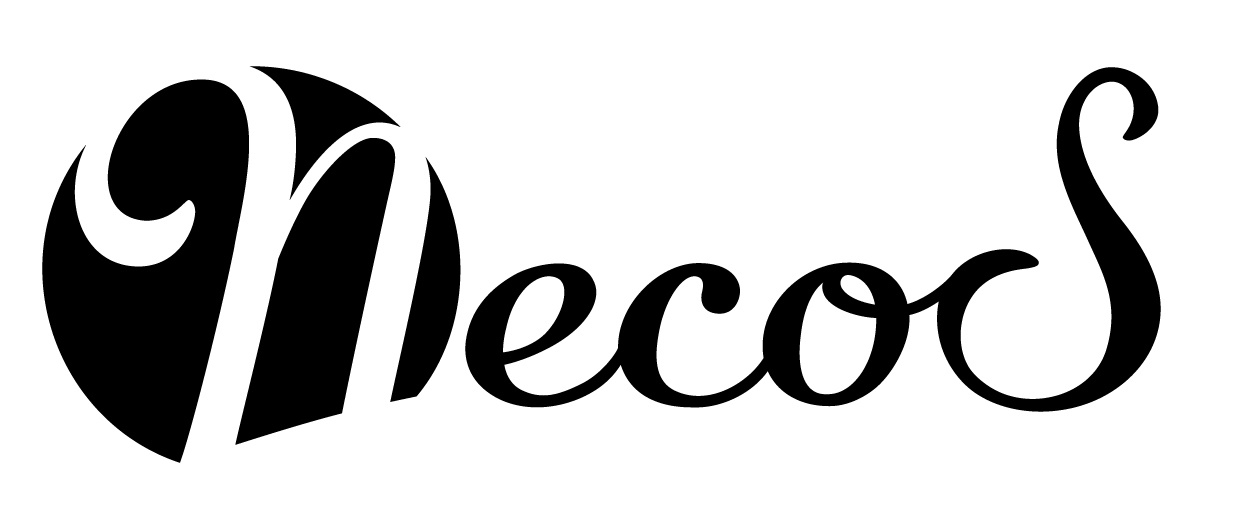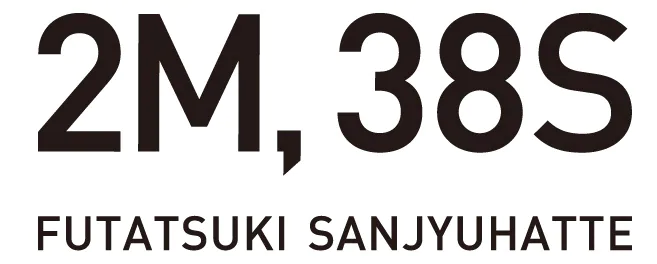About Hamachirimen
What is Hamachirimen?
Chirimen (silk crepe) was first introduced to Sakai, Osaka in 1573
by a craftsman from the Ming empire, who came to Japan.
Chirimen was introduced to Nagahama in the 1740s about 170 years later,
and we now see the prosperity of the present day.
Nakamura Rinsuke and Inui Shokuro are the pioneers of Hamachirimen.
When the two men began to sell Hamachirimen in the Kyoto market,
which was the capital of Japan at that time,
there was a movement by the people of Kyoto to boycott Hamachirimen.
They were afraid that Hamachirimen,
with its excellent quality, would compete with the Nishijin silk crepe of Kyoto.
The movement developed to the extent that the people appealed to the Nijo municipal office
to prevent Hamachirimen from entering Kyoto.
The two men then appealed to the Nijo municipal officeto allow them to sell Hamachirimen in Kyoto,
but the office rejected their appeal.
The two troubled men appealed to the Hikone feudal domain for assistance
so that they could sell the crepe in Kyoto.
Since Hikone Domain was looking for an industry to shift over from agriculture,
the appeal made by the men was accepted.
With the generous protection from the feudal domain,
such as appointing the two men as weavers, not to mention sale in Kyoto,
Hamachirimen became a product of Nagahama,
exclusive only to that region, instead of spreading outside.
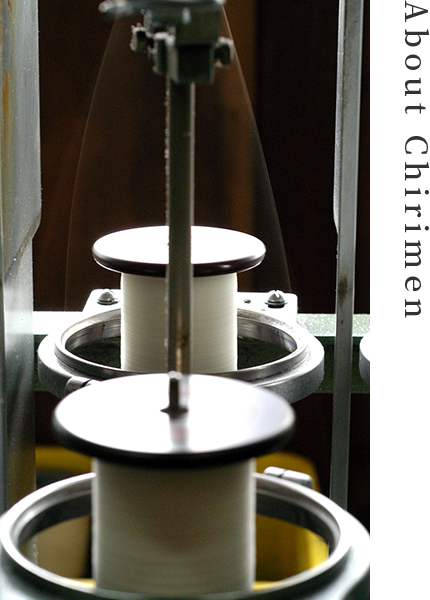
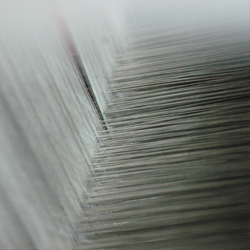
Chirimen is woven by crossing warp yarns having no twist, and highly twisted weft yarns.
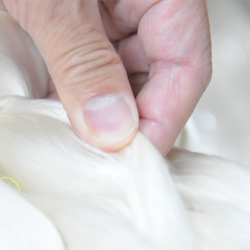
Silk, especially raw silk (the only long fiber among natural fibers), is used as a raw material. Compared to cotton and other materials, silk has superior breathability with moisture absorption and desorption 1.3 to 1.5 times that of different materials.
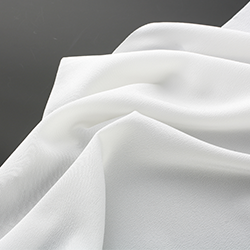
The fabric surface is uneven.
These are called "crimps", and despite the unevenness of the fabric surface, the fabric has a soft texture.
* Crimps: It is the unevenness of the fabric surface that is formed when highly twisted weft yarns shrink due to scouring.
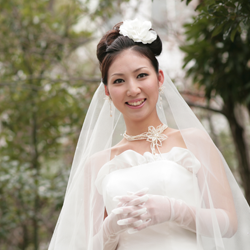
Though Chirimen has long been used mainly for Kimono, Furoshiki (wrapping cloth) and Fukusa (cloth envelope), in recent years, due to its soft texture, Chirimen is now used in Western clothing such as wedding dresses and stoles.
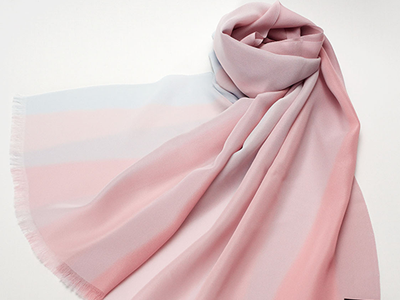

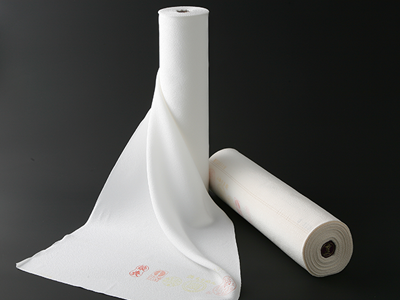
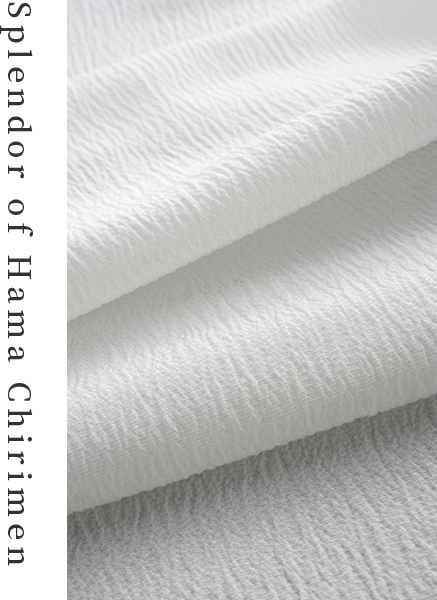

Making the most of the characteristics of silk, cool in summer and warm in winter.
Hamachirimen is manufactured from silk.
The moisture absorption capacity of silk is 1.3 to 1.5 times that of cotton, and the moisture desorption capacity is also approximately 1.3 times that of cotton.
These properties of silk fabrics have given rise to the theory of "quick absorption" and "quick-drying" of sweat, which keep you cool in summer, and warm in winter since air is trapped in the gaps between the intricate fibers, even though the fabric is thin.
◎ Moreover, the fabric is light!
Since we wear many layers of clothes during winter, thin clothes are pleasant.

Protects your skin from drying and dryness
Since the silk fiber absorbs UV rays, the fabric helps prevent dark spots from being formed on the skin.
◎ Ideal for innerwear
Silk is used for undergarments and innerwear due to its excellent absorption capacity and quick-drying (moisture retention) properties.
The fabric is especially popular with mountaineers.

Hamachirimen manufactured from silk
Hamachirimen, manufactured from silk, is a fabric that makes the best use of the characteristics of silk and has long been used as a material for kimonos.
A kimono that seems thick can be light and breathable when manufactured from Hamachirimen, which makes it easy to move for the person wearing the Kimono.
Types of Chirimen
There are many types of Chirimen, depending on the weaving method.
Some of the types are introduced here.
Each type has its characteristics, such as luster and fineness of texture.
The usage differs according to the product,
and the purpose for which it is manufactured,
inquire with us before placing an order.
古代縮緬
Kodai Chirimen
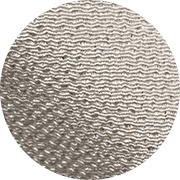
This material is characterized by large crimps.
The weft has two right-laid yarns and two left-laid yarns that are highly twisted and woven alternately and is known as Futakoshi Chirimen.
This is the oldest type of Chirimen.
一越縮緬
Hitokoshi Chirimen
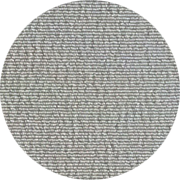
This is a plain weave fabric where right-laid and left-laid highly twist yarn are woven alternately to make weft yarn.
Hitokoshi Chirimen is characterized by tiny crimps and has a luxury feel.
変り縮緬
Kawari Chirimen
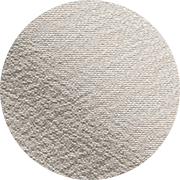
This is a plain weave where highly twist yarn in the weft are further doubled and twisted.
It is characterized by a smaller degree of stretching and shrinking.
Many different types depending on how the yarns are doubled and twisted.
Some of the main types are: Kawari Hitokoshi, Kawari Mitsukosi and Kawari Kodai.
東雲縮緬
Shinonome Chirimen
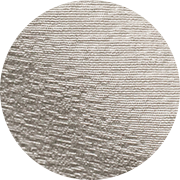
The highly twisted yarn weft yarns are untwisted in this Chirimen.
This Chirimen is called Shinonome (eastern clouds) because of the cloud-like crimps that are formed.
古浜縮緬
Kohama Chirimen
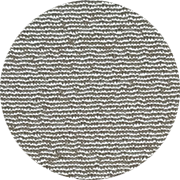
The yarns of Kodai Chirimen are thinned to give a lightly-crimped appearance.
うずら縮緬
Uzura Chirimen
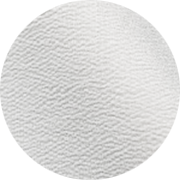
This is a plain weave fabric in which several right and left highly twist yarn are woven alternately (Mitsukoshi (three yarns) to Rokkoshi (six yarns)) to manufacture weft yarn.
This is characterized by even larger crimps than Kodai Chirimen.
